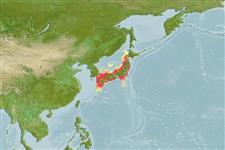Environment: milieu / climate zone / depth range / distribution range
Ökologie
seewasser; ozeanodrom (Ref. 51243); tiefenbereich 0 - 275 m (Ref. 54927), usually 50 - 275 m (Ref. 54927). Tropical; 46°N - 13°N, 105°E - 148°E
Northwest Pacific: southern Japan, Korean Peninsula to the East China Sea. Pacific Ocean off the coast of southeast Asia.
Length at first maturity / Size / Gewicht / Alter
Maturity: Lm 19.0, range 18 - 20 cm
Max length : 50.0 cm TL Männchen/unbestimmt; (Ref. 56557); common length : 35.0 cm TL Männchen/unbestimmt; (Ref. 56557); max. veröff. Gewicht: 660.00 g (Ref. 40637); max. veröff. Alter: 12 Jahre (Ref. 56557)
Rückenflossenstacheln (insgesamt) : 9; Rückenflossenweichstrahlen (insgesamt) : 30 - 35; Afterflossenstacheln: 3; Afterflossenweichstrahlen: 26 - 30; Wirbelzahl: 24. Species with no finlets and the entire lateral line with scutes (69-73) (Ref. 41299).
Adults occur on continental waters (Ref. 41299). Pelagic (Ref. 52947). Juveniles associate with drifting seaweed (Ref. 12114, 12115).
Masuda, H., K. Amaoka, C. Araga, T. Uyeno and T. Yoshino, 1984. The fishes of the Japanese Archipelago. Vol. 1. Tokai University Press, Tokyo, Japan. 437 p. (text). (Ref. 559)
IUCN Rote Liste Status (Ref. 130435)
Bedrohung für Menschen
Harmless
Nutzung durch Menschen
Fischereien: hoch kommerziell; Aquakultur: kommerziell
Tools
Zusatzinformationen
Download XML
Internet Quellen
Estimates based on models
Preferred temperature (Ref.
123201): 1.8 - 22, mean 13.8 °C (based on 75 cells).
Phylogenetic diversity index (Ref.
82804): PD
50 = 0.5001 [Uniqueness, from 0.5 = low to 2.0 = high].
Bayesian length-weight: a=0.01072 (0.00875 - 0.01312), b=2.97 (2.94 - 3.00), in cm total length, based on LWR estimates for this species (Ref.
93245).
Trophic level (Ref.
69278): 3.4 ±0.45 se; based on food items.
Widerstandsfähigkeit (Ref.
120179): mittel, Verdopplung der Population dauert 1,4 - 4,4 Jahre. (K=0.14-0.38; tmax=6).
Prior r = 0.55, 95% CL = 0.36 - 0.82, Based on 1 full stock assessment.
Fishing Vulnerability (Ref.
59153): Low to moderate vulnerability (34 of 100).
Climate Vulnerability (Ref.
125649): Low vulnerability (20 of 100).
Nutrients (Ref.
124155): Calcium = 386 [198, 652] mg/100g; Iron = 4.01 [2.35, 6.81] mg/100g; Protein = 18.6 [17.7, 19.4] %; Omega3 = 0.208 [0.126, 0.330] g/100g; Selenium = 50.3 [30.5, 90.1] μg/100g; VitaminA = 28 [7, 124] μg/100g; Zinc = 3 [2, 4] mg/100g (wet weight);
